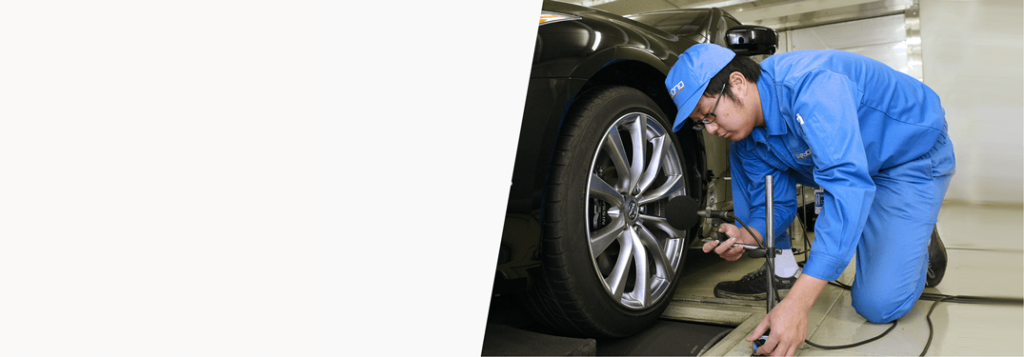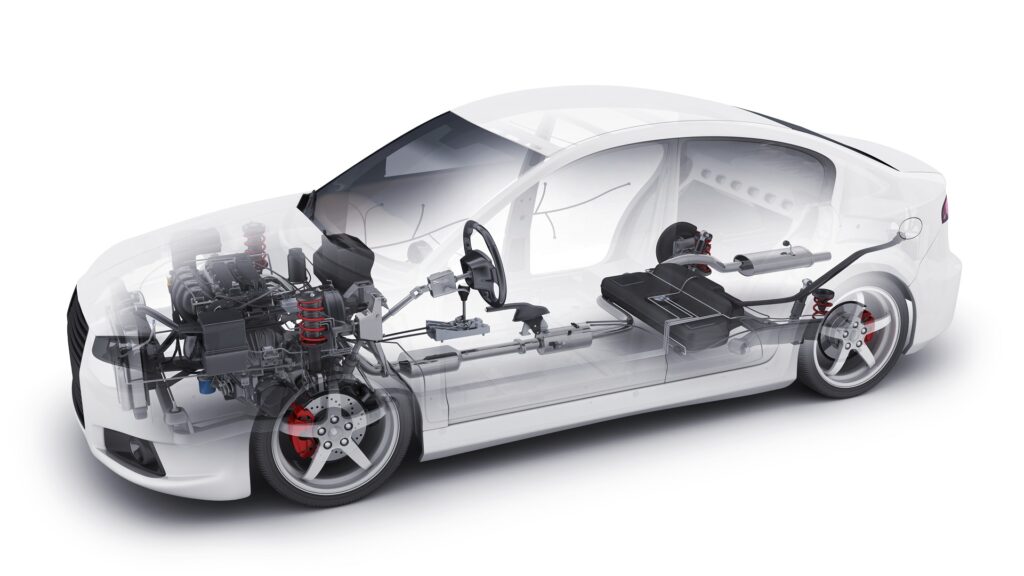我们每个人都会确定汽车某些消费特性的重要性。例如,有人对空间更感兴趣,有人对可操纵性更感兴趣。但声学舒适度对每个人都很重要。您无需成为专家即可知道汽车是否嘈杂。第一个结论可以在您开始旅行时得出。同时,对行驶平稳性或制动的评估需要时间。在行业中,有一个综合概念,即 NVH(噪音、振动、声振粗糙度)。
如果 NVH 领域的一切都不好,人们会身体上感觉到它:神经系统和大脑超负荷,注意力受损,音调和反应下降。因此,驾驶现代安静的汽车长途驾驶更容易。请不要认为“隔音效果随着时间的推移变得更好”!从理论上讲,隔音是提供声学舒适度的最后但不一定是最有效的方式。现在让我们来了解一下原因。
如果不深入研究物理和数学,很难谈论 NVH。为了不让我们陷入高深的争论,我们将简化一些事情。但说噪音是由振动产生的并没有错。后者本身也是有害的,尤其是对技术设备而言。
因此,任何振动都有来源。汽车的噪音和振动主要由发动机和排气系统、滚动的车轮和车身周围的空气流动产生。还有另外几十个来源,但上面列出的是主导。通常,在城市速度下,主要的“贡献”是由动力装置做出的,在高速公路上以 90-100 公里/小时的速度行驶时,所有东西几乎都“唱歌”,而在 120-130 公里/小时之后,首先要担心的是空气动力学和道路来源的干扰。这是理论上的。
任何噪音,例如来自发动机的噪音,都以两种方式传播。机械上 – 通过与源具有物理连接的车身面板和结构元件的振动,以及直接通过空气,包括“穿透”相同的面板。因此,有三种主要方法可以处理噪音。按优先顺序,这分别是降低噪音源的强度、通过结构元件衰减二次辐射,第三种方法是隔音,即“捕捉”通过空气传播的成分。
例如,减少发动机噪音始于燃烧过程的组织,如果可能的话,应使其平稳。大型声音发射器——气缸体、气缸盖、油底壳——的设计应使其不会与气缸中的工作过程产生共振。越来越多的此类元件由塑料制成,吸音材料直接应用于它们,整个发动机如果可能的话被“封装”。排气系统过去会产生很大的噪音,但催化剂和微粒过滤器会平滑废气脉动以支持排气消音器,这在不知不觉中起到了帮助作用。
动力装置的支架应防止振动进一步传播。它们的连接点应选择不会引起车身振动。第一辆量产的 VAZ-2108 的历史令人难忘,由于前支撑位置不正确,怠速时的振动和噪音达到了令人不舒服的程度。移动支撑为时已晚,它变得更软了,这带来了许多其他问题……
如今,动力装置的液压支撑已不再是异类,它结合了弹性和抑制功能(就像悬架中的弹簧和减震器的组合)。主动支撑产生与振动相反的相位运动或根据条件改变其刚度是最有效的。
应尽量减少仍能到达车身的振动。避免共振非常重要。刚度最大的车身并不一定安静。整体结构可以减少共振,但会增加结构噪音的传输。
与记者不同,汽车工程师经常使用车身共振频率的概念,而不是扭转刚度。此外,最佳频率不应尽可能高或低 —— 它应该恰好避免共振。因为车身只是最复杂的振动系统的成员之一,其中包括弹性悬架元件、轮胎、座椅和所有振动源。
车身的承载布置是考虑到上述所有因素而开发的。即使是那些不承受严重载荷的部件,也有加强筋和冲压加固板来尽可能地抵消振动。即使在大规模汽车行业中,也会使用高强度和热处理钢、可变厚度轧制、车身部件粘合技术和其他技巧。同时,计算机模拟仍会检测到残余振动。你应该如何处理它们?

简而言之,您需要在这些点处改变自然振动的频率以避免共振。例如,通过使用减振器 – 刚性或软固定的质量。在维修时,如果在前保险杠的内部某处发现一根三公斤重的铸铁棒,请不要感到惊讶:它并没有在工厂被遗忘,而是严格按照设计计算拧紧,以平衡某些频率的波动。较小的负载通常放在悬架或排气系统的部件上。
泡沫具有与建筑泡沫相似的特性,在某些地方倒入车身空腔中,例如,沥青垫粘在平板上。但不是像在车库改装中那样遍布整个空间,而是有选择地,根据计算机建模选择位置。噪音利用任何漏洞,因此车身,特别是发动机护罩中的漏洞数量被最小化。它们中的任何一个都经过精心隔离。值得庆幸的是,加速器和自动变速器的机械驱动已成为过去,它们曾是传递振动的强大渠道。只有在选择了所有设计储备之后,才需要隔音。
如果前几个阶段一切都做得正确,就不需要太多隔音材料了。例如,第七代高尔夫使用的隔音材料比其前身少了四公斤。现代软垫和地毯是技术杰作,精确地模制到发动机护罩或地板的轮廓和浮雕上。在汽车内部,你根本不能没有覆盖物,因为它也起到隔热作用。但不要对后备箱备胎周围的裸露金属感到惊讶——根据制造商的说法,这意味着噪音已通过初步措施成功抑制。
这样的“协议”不仅适用于发动机噪音,也适用于每个来源。相信我们,我们可以在单独的文章中写出如何对抗轮胎滚动的轰鸣声、空气动力学干扰或外部声音。有很多细微差别、微妙之处和技巧。自制粘贴和额外的垫子当然有效果,但这种方法不能称为理性的。您不仅需要花费大量金钱购买材料并努力获得几分贝的优势,而且还要携带几十公斤的额外重量,并以增加燃料消耗为代价。
最新的趋势是主动降噪系统,它使用音响系统的扬声器产生与有害声音相位相反的有用声音。一个声音和一个声音应该能带来安静。可惜的是,这样的系统工作不准确,它们的功率和频率范围有限:这是物理原理。发动机和道路的噪音在 0.009 秒内到达驾驶员和乘客的耳朵,最好的防噪音系统在 0.002 秒内做出反应。很明显,它们会有所改进——但最重要的是不要像 ESP 那样,安全电子设备的发展变成了基本设计原则的弱化……
声音的频率越高,越令人不安。例如,疲劳效应在 2000-4000 Hz 频率范围内从 80 分贝 (dB) 的音量开始,在 5000-6000 Hz 时已经达到 60 dB。结构性噪音主要通过车身传播,频率主要在 500 Hz 以下,耳朵会听到更低频率的嗡嗡声和低音。在汽车中,这些噪音主要来自道路,但也有一部分来自排气系统。
而声学传播的干扰主要在 1000 Hz 以上的频率下(800 Hz 以上为高频)。在这里,动力装置和空气动力学主要产生噪音。人可以感知 20 Hz 至 20,000 Hz 范围内的声音,但我们通常要处理汽车中 30-8500 Hz 的声音。
除了频谱组成(噪音频率)之外,频谱的性质也很重要。还有宽带噪音,即声音和音调噪音的混合。例如,动力转向电动机的啸叫声或空调内部制冷剂的喘息声。一辆汽车可以产生数百个这样的特定“音符”,好的制造商会在道路测试阶段将它们彻底“摧毁”。
顺便说一句,分贝的噪音音量值不一定与人的主观感受相对应。至少因为我们的听觉器官对不同频率的声音的感知不同。是的,噪音计也会在复杂的程序中处理来自麦克风的信号,试图复制耳朵的灵敏度。但它并不总是有效。在实践中,汽车制造商不仅必须关注测量,还必须关注专家的意见。有时将声音转移到更令人愉悦的频率比抑制它更容易。所有这些都在道路测试中得到解决。
无论是欧盟还是美国,乘用车的内部噪音都没有限制——只有外部噪音。很明显,制造商非常希望让客户在车内感到舒适。但是,例如,俄罗斯有自己的方式。在认证过程中,所有新车,包括劳斯莱斯或梅赛德斯 – 迈巴赫 S 级,都要接受符合技术法规“轮式车辆安全”附件 3 的检查。也就是说,他们实际上在驾驶室内悬挂麦克风,并使用多种方法测量噪音——包括匀速行驶和加速行驶时。
一般来说,噪音不应超过 77 分贝,但也有很多例外。旅行车和半驾驶室布局的汽车,如小型货车,已经允许 79 分贝。如果汽车被认证为 SUV(甚至一些跨界车也是如此),这些值可以超过 2 分贝。有一次,收藏版保时捷 911 R 轿跑车没有进入俄罗斯,就是因为不符合内部噪音水平的具体要求。
不过,跑车有单独的脚注。如果整备重量小于两吨,功率重量比高于 75 kW/t(102 马力/吨),则允许超过 4 分贝。如果每吨的噪音超过 110 kW(几乎 150 马力),则测试将以温和的方式进行,并且只能以恒定速度进行。许多民用汽车都符合这一框架。即使是功率不那么强大的 145 马力 Lada Vesta Sport 也有每吨 109 马力。那么,为什么内部噪音认证会大惊小怪,迫使制造商承担最终将包含在汽车价格中的不必要成本呢?
奇怪的是,在苏联时期的汽车理论教科书中,通常只提到噪音和振动。对抗它们通常是基于残余原则:当车身和发动机都准备就绪时,设计师开始研究:如何让内部更安静?例如,他们通过跳过前两个步骤来添加相同的绝缘材料:对抗干扰源及其传播。今天,只有在制造商在布局阶段考虑 NVH 时,才能制造出具有竞争力的汽车,更不用说设计了。
现代技术给声学工程师带来了新的挑战。主动减轻车身重量、使用铝合金或复合材料等轻质材料都会导致结构噪音的增加。轮胎越来越宽,因此噪音也越来越大。为了追求环保,气缸内的燃料燃烧过程往往变得不那么平稳,也就是说,它会产生更多的振动。

放弃内燃机转而使用电动机并没有让任务变得更容易。发动机发出的频谱不是通常的 2500-3000 Hz,而是在令人不舒服的 5000 Hz 左右,其中混合了一种新型噪音 —— 电磁噪音。还有一些以前被忽略的新声音,因为它们被内燃机淹没了。例如,由气候控制减震器产生的声音。如果我们进一步展望强加给我们的无人驾驶未来,NVH 的作用只会越来越大,因为除了汽车的声学舒适度之外,几乎没有什么可讨论的。噪音似乎是一种我们每个人都能理解的物质……
您可以在這裡閱讀原文: https://www.drive.ru/technic/5ebe5f04ec05c49c7e0000eb.html

出版 八月 19, 2021 • 3m






